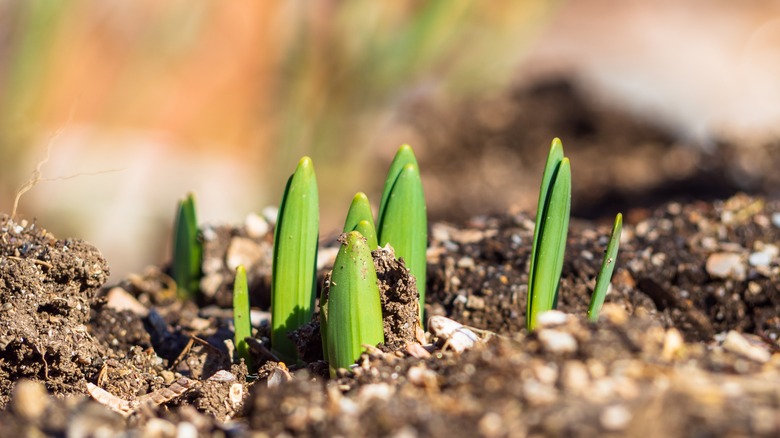The Best Way To Protect Young Spring Bulbs In The Garden
Waiting for spring bulbs to bloom is an exciting time in the garden. There are a few things gardeners can do during spring clean up, before and after spring bulbs start to appear, to make the most of the blooming season. One important thing to remember is to avoid cleaning up all of the leaves and debris until after the last hard frost date. The first spring clean-up should be done with a light hand to protect early plants from freezing and to provide shelter and food for insects and other creatures.
Raking all of the leaves and debris off your flower beds too early is problematic for a number of reasons. Raking with a large rake, especially a metal rake, can damage the young plants that are just starting to poke through the ground; once damaged, the leaves tend to remain that way through the blooming season.
Also, raking and removing the protective covering of leaves too early can actually harm the overall health and biodiversity of your garden. There are many insects and birds who rely on the cover of leaves and decaying plant material for shelter and food. Removing this material means affecting the seasonal population of pollinators and other beneficial insects. Leaving the leaves until temperatures get warmer is helpful for the survival of plants and beneficial insects. But gently lifting and separating the leaves on flower beds can be done in ways that are helpful.
Tools to use or avoid in spring garden clean up
Using a large metal or plastic rake is fine for gently cleaning up the lawn or open areas. But in flower beds or areas where there are spring bulbs, you should avoid it. The tines can tear or shred the tender young leaves of crocuses, daffodils, tulips, or other spring flowers. Rakes can also damage the early foliage of hostas, irises, peonies, and daylilies when they first appear above ground. This injured foliage can be rather unsightly as the plant moves through its growth cycle for the season.
But you can do some spring cleanup while protecting your young plants. Leaves can get matted and thick from moisture and having been frozen together. Breaking up these thick, matted layers of leaves can give bulbs and spring-blooming perennials some much-needed air and sunlight. Do this carefully with small bamboo rakes, small garden forks, or even better, with your gloved hands. Leaving a light layer of leaves will still offer protection from a late frost or snowstorm.
But as you work in your flower beds, note where you have areas with leaf cover that is not on top of any bulbs or perennials. Consider leaving this area undisturbed until late spring or beyond, if practical. This can really help to improve the biodiversity of your garden as well as protect insect larvae waiting to emerge later in the spring.
Waiting to rake improves garden vitality
Later-blooming spring bulbs such as tulips, camassia, and muscari will emerge a bit later than daffodils, crocuses, and snowdrops, so some leaf cover can be left over these later flowering varieties. Leaving some of your early spring garden undisturbed will help protect any garden-friendly insects or creatures living inside or underneath. Even tiny piles of leaves, branches, twigs, seedpods, and flower heads provide food and shelter for a wide range of insects, birds, and wildlife.
Protecting pollinators who are overwintering in the garden is crucial to maintaining a healthy environment for these crucially important winged creatures until they can emerge in spring to feed. Once the warmer weather of spring arrives, these later-blooming bulbs will have buds appearing, and blossoming fruit trees such as crabapples and plums will attract pollinating insects such as bees, moths, and butterflies to their sweet nectar-filled flowers.
When the fruit trees in your area have begun to flower, and May-blooming bulbs are in bud, this is perfect timing for a bit more rigorous spring clean-up in your garden. But remember to be gentle with those rakes. Waiting a few extra weeks to clear all the leaves off your flower beds, and doing an early spring clean-up with a gentle touch, will improve the overall health and vitality of your garden.


